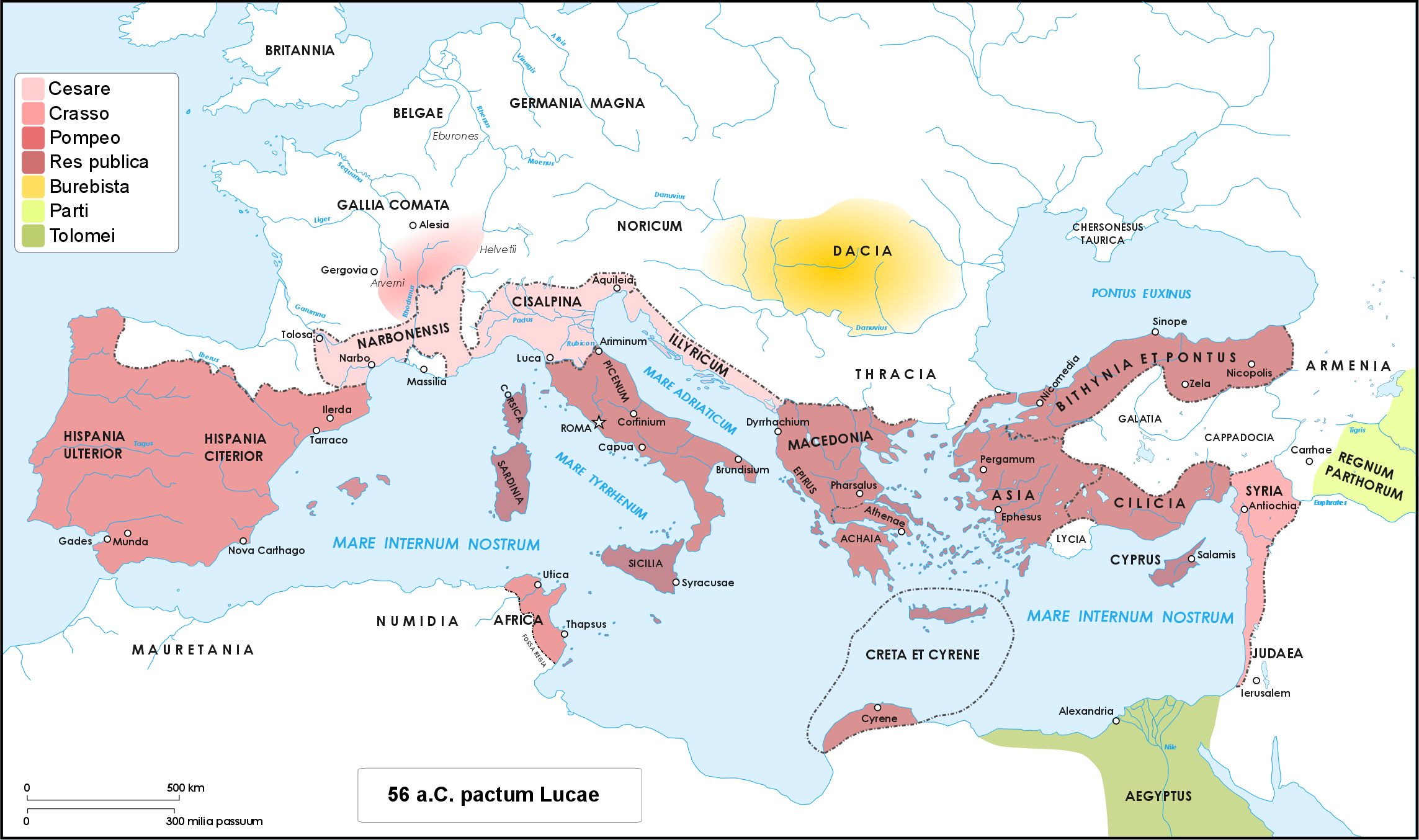|
Siege Of Corfinium
The siege of Corfinium was the first significant military confrontation of Caesar's Civil War. Undertaken in February 49 BC, it saw the forces of Gaius Julius Caesar's Populares besiege the Italian city of Corfinium, which was held by a force of Optimates under the command of Lucius Domitius Ahenobarbus. The siege lasted only a week, after which the defenders surrendered themselves to Caesar. This bloodless victory was a significant propaganda coup for Caesar and hastened the retreat of the main Optimate force from Italia, leaving the Populares in effective control of the entire peninsula. Background Over the previous decade Julius Caesar had scored a series of military victories in the previously unconquered lands of Germania, Britannia, and most prominently Gaul during the Gallic Wars. These victories in the name of the Roman Republic, along with previous reforms he had made as consul, won him massive popularity among the people and the Roman Senate was becoming increasingl ... [...More Info...] [...Related Items...] OR: [Wikipedia] [Google] [Baidu] |
Caesar's Civil War
Caesar's civil war (49–45 BC) was one of the last politico-military conflicts of the Roman Republic before its reorganization into the Roman Empire. It began as a series of political and military confrontations between Gaius Julius Caesar and Gnaeus Pompeius Magnus. Before the war, Caesar had led an invasion of Gaul for almost ten years. A build-up of tensions starting in late 49 BC, with both Caesar and Pompey refusing to back down led, however, to the outbreak of civil war. Eventually, Pompey and his allies induced the Senate to demand Caesar give up his provinces and armies. Caesar refused and instead marched on Rome. The war was a four-year-long politico-military struggle, fought in Italy, Illyria, Greece, Egypt, Africa, and Hispania. Pompey defeated Caesar in 48 BC at the Battle of Dyrrhachium, but was himself defeated decisively at the Battle of Pharsalus. Many former Pompeians, including Marcus Junius Brutus and Cicero, surrendered after the battle, wh ... [...More Info...] [...Related Items...] OR: [Wikipedia] [Google] [Baidu] |
Sulmo
Sulmona ( nap, label= Abruzzese, Sulmóne; la, Sulmo; grc, Σουλμῶν, Soulmôn) is a city and ''comune'' of the province of L'Aquila in Abruzzo, Italy. It is located in the Valle Peligna, a plain once occupied by a lake that disappeared in prehistoric times. In the ancient era, it was one of the most important cities of the Paeligni and is known for being the native town of the Roman poet Ovid, of whom there is a bronze statue, located on the town's main road and named after him. History Ancient era Sulmona was one of the principal cities of the Paeligni, an Italic tribe, but no notice of it is found in history before the Roman conquest. A tradition alluded to by Ovid and Silius Italicus, which ascribed its foundation to Solymus, a Phrygian and one of the companions of Aeneas, is evidently a mere etymological fiction. The first mention of Sulmo occurs in the Second Punic War, when its territory was ravaged by Hannibal in 211 BC, who, however, did not attack the cit ... [...More Info...] [...Related Items...] OR: [Wikipedia] [Google] [Baidu] |
Illyricum (Roman Province)
Illyricum was a Roman province that existed from 27 BC to sometime during the reign of Vespasian (69–79 AD). The province comprised Illyria/Dalmatia in the south and Pannonia in the north. Illyria included the area along the east coast of the Adriatic Sea and its inland mountains, eventually being named Dalmatia. Pannonia included the northern plains that now are a part of Serbia, Croatia and Hungary. The area roughly corresponded to the part or all of territories of today's Albania, Kosovo, Montenegro, Serbia, Bosnia and Herzegovina, Croatia, and Slovenia. Name and etymology The term Illyrians was used to describe the inhabitants of the area as far back as the late 6th century BC by Hecataeus of Miletus. Geography Illyria/Dalmatia stretched from the River Drin (in modern northern Albania) and Thessaloniki (Greece)to Istria (Croatia) and the River Sava in the north. The area roughly corresponded to modern northern Albania, Serbia, Kosovo, Slovenia, Montenegro, Bosnia a ... [...More Info...] [...Related Items...] OR: [Wikipedia] [Google] [Baidu] |
Transalpine Gaul
Gallia Narbonensis (Latin for "Gaul of Narbonne", from its chief settlement) was a Roman province located in what is now Languedoc and Provence, in Southern France. It was also known as Provincia Nostra ("Our Province"), because it was the first Roman province north of the Alps, and as Gallia Transalpina ("Transalpine Gaul"), distinguishing it from Cisalpine Gaul in Northern Italy. It became a Roman province in the late 2nd century BC. Gallia Narbonensis was bordered by the Pyrenees Mountains on the west, the Cévennes to the north, the Alps on the east, and the Gulf of Lion on the south; the province included the majority of the Rhone catchment. The western region of Gallia Narbonensis was known as Septimania. The province was a valuable part of the Roman Empire, owing to the Greek colony of Massalia, its location between the Spanish provinces and Rome, and its financial output. Names The province of Gallia Transalpina ("Transalpine Gaul") was later renamed Gallia Nar ... [...More Info...] [...Related Items...] OR: [Wikipedia] [Google] [Baidu] |




